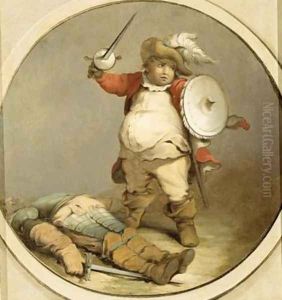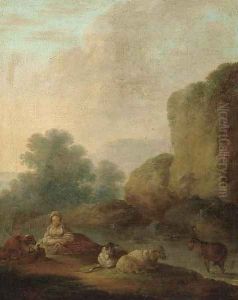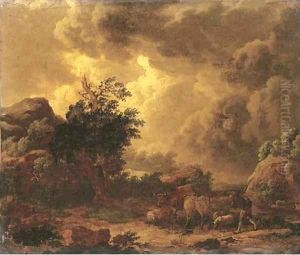(attr.to) Loutherbourg, Philip James de Paintings
Philip James de Loutherbourg, also known as Philippe-Jacques de Loutherbourg, was a multifaceted artist of Franco-German origin, who became famous not only as a painter but also as a stage designer and early innovator in visual effects. Born in Strasbourg, France, on October 31, 1740, he was the son of an esteemed miniaturist who influenced Loutherbourg's early interest in the arts.
De Loutherbourg initially trained under his father, before moving to Paris to study under the history painter Charles-André van Loo. His talent quickly became apparent, and he gained membership in the prestigious Académie Royale de Peinture et de Sculpture at the young age of 25. His early works were characterized by dramatic lighting and a keen attention to detail, elements that would become hallmarks of his style.
In 1771, de Loutherbourg relocated to London, where he would spend the remainder of his career. His move coincided with a significant shift in his professional focus; while he continued to paint, his interest in theatrical design and production burgeoned. He was employed by David Garrick, the manager of the Drury Lane Theatre, as the chief scene painter. Loutherbourg revolutionized the world of stage design with his innovative use of lighting and machinery to create stunning, immersive effects. His 'Eidophusikon', a form of early cinema, was a miniature theatre that used a variety of mechanisms and lighting effects to create naturalistic scenes.
As a painter, Loutherbourg was known for his landscapes and battle scenes, which were infused with a sense of romanticism and the sublime. His depictions of the English countryside and dramatic events like shipwrecks or military encounters were particularly celebrated. These works reflected the shifting tastes of the time, moving away from the classical and embracing the emotive potential of the natural world.
Despite his success in England, de Loutherbourg maintained ties to France, and during the French Revolution, he created several works that engaged with the political turbulence of his homeland. He returned to more traditional painting in his later years, continuing to exhibit his works at the Royal Academy of Arts, where he had been elected as a member in 1781.
Philip James de Loutherbourg died on March 11, 1812, in Chiswick, London. His legacy lives on in his contributions to the world of theatre and his influence on the Romantic movement in painting. His works can be found in various museums and collections, testament to his enduring impact on the arts.


